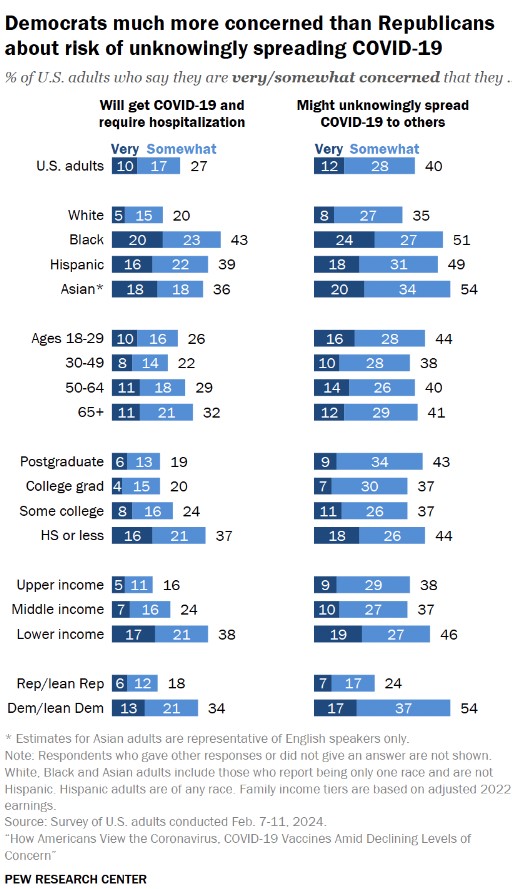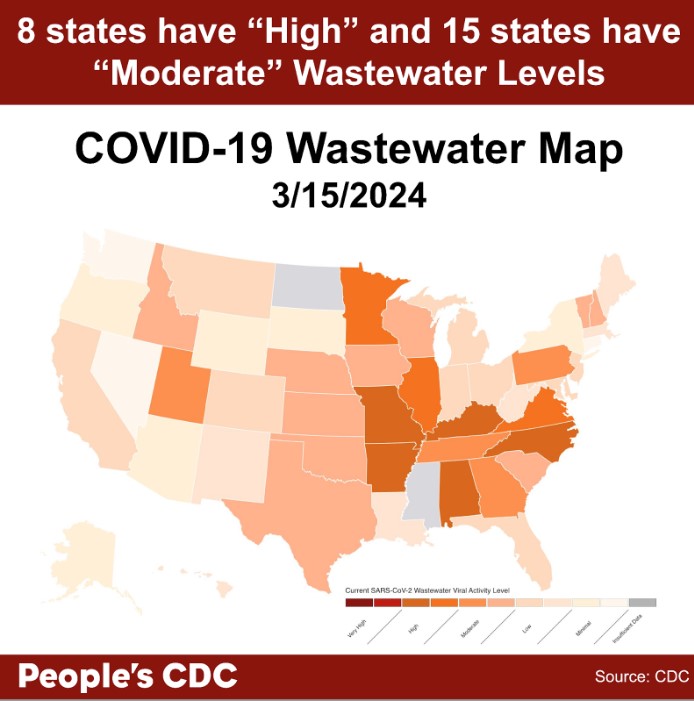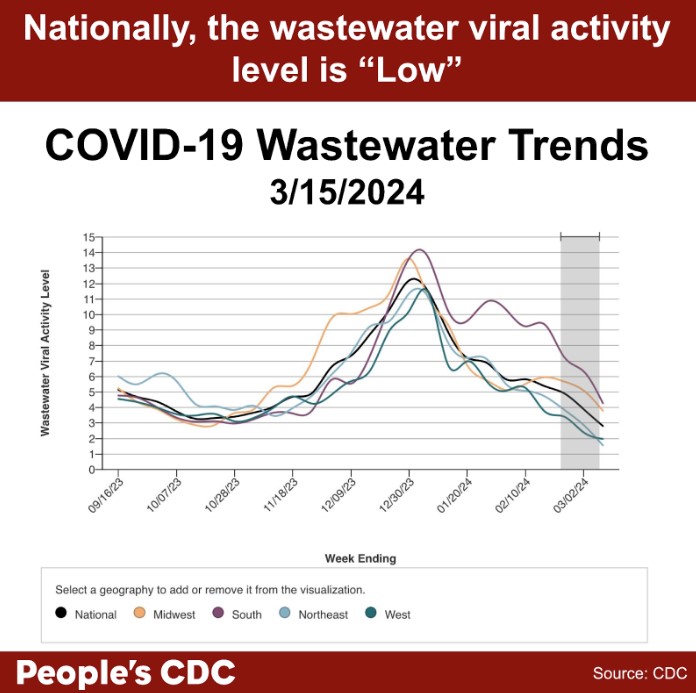Amid the CDC’s COVID-minimizing and dangerous rollback to isolation guidance, a new Pew Research poll shows that 27% of Americans are very or somewhat concerned that they will get COVID and require hospitalization, and 40% (nearly half) of Americans are very or somewhat concerned that they will unwittingly spread COVID to others. This number rises substantially for low income brackets, and Black, Hispanic, and Asian adults. Concern about hospitalization was highest in adults with a high school education or less. Despite efforts by the CDC, the Biden Administration, and corporate media to downplay the public’s concern about COVID, these numbers show that a substantial proportion of Americans care about protecting one another.

A popular program providing free rapid antigen tests through the USPS ended on March 9, 2024. Despite the limitations of rapid antigen tests, these home tests continue to be a vital way to quickly identify COVID cases, both to prevent further onward spread as well as to identify the need for treatment with Paxlovid. You can use our letter campaign to let your elected officials know we still need free rapid home tests.
COVID wastewater levels are decreasing, with no states registering “Very High” levels as of 3/15/2024. Eight states are currently at “High” and 15 are at “Moderate” levels of SARS-CoV-2 detected in wastewater.
Wastewater levels show a downward trend in the provisional data (gray shaded area) in all regions. The national wastewater levels are overall indicated as “Low.” Lower wastewater activity is an indication of lower overall viral spread, which is certainly a good thing. However, the “Low” designation is not a representation of low risk in our day-to-day lives, and continued masking and multilayered precautions continue to be necessary to protect ourselves and our communities. State and local trends can also provide additional information, where available.
A recent Axios article highlights the expanding broad utility of wastewater testing for COVID and other infectious diseases, as well as the uncertain footing of the funding and infrastructure for this essential surveillance tool. We encourage you to write your elected officials to let them know you want to keep and expand wastewater testing in your area and nationally.
Wins
On March 13, the People’s CDC hosted a press conference to push back on the CDC’s elimination of COVID isolation guidance and demand accountability to the public (watch the video o read the press release). The online publication (pre-proof) of the People’s CDC External Review in the peer-reviewed scientific journal American Journal of Preventive Medicine Focus was also announced, which is an important authoritative resource highlighting both shortcomings of the CDC’s approach and recommendations for a more transparent, effective, and equitable pandemic response going forward. The full External Review report can be found on the People’s CDC website.
March 15 was Long COVID Awareness Day, and Senator Bernie Sanders along with six cosponsors (Tim Kaine, Edward Markey, John Hickenlooper, Tina Smith, Robert Casey, and Tammy Baldwin) introduced Resolution 590 to formally recognize March 15 as Long COVID Awareness Day. You can ask your senators to support this resolution using this letter campaign. Senator Sanders released a video promising legislation to increase funding for Long COVID research and clinical care, as well as emphasizing the importance of prevention, including vaccination and masking. For more info on Long COVID Awareness Day, see the “Long COVID” section below.
When we make our voices heard, whether with the press, with scientific publications, or with elected officials, we win.
Variants
In the CDC’s most recent Nowcast predictions, JN.1 continues to be the most prevalent variant in the United States (86.5%), with a predicted decrease in JN.1 and sublineage JN.1.13 increasing (9.5%).
Graphic source: CDC Variant Tracker
Vaccines
The CDC has recommended spring boosters for people age 65 and older, at least 4 months after the previous updated dose. As of 3/2/2024, only about 42.4% of adults age 65 and older had gotten an updated vaccine, and many who were vaccinated in the fall may not realize they are eligible for another dose.
In addition to the spring boosters recommended for people aged 65 and older, immunocompromised people are eligible for more frequent vaccination. The CDC states, “You can self-attest to your moderately or severely immunocompromised status, which means you do not need any documentation of your status to receive COVID-19 vaccines you might be eligible to receive.”
As a reminder, the currently available COVID vaccine formulations (2023-2024, first available in fall 2023) are effective against the JN.1 variant, with about 54% protection against symptomatic disease. For people of all ages, immunity wanes after 6 months, and, although current eligibility is more limited, we continue to support access to vaccination at least every 6 months for all ages.
If you have not received one of the updated COVID vaccines released last Fall, you can use this tool to find local vaccine providers that are Bridge Access Participants. The Bridge program is currently available through December 31, 2024.
COVID in Kids
In a recent report in the CDC’s MMWR publication, cases of Multisystem Inflammatory Syndrome in Children (MIS-C) in 2023 were highlighted. MIS-C is an inflammatory response to a COVID infection that usually occurs 2-6 weeks following an infection. MIS-C may be serious and can affect the heart, lungs, kidneys, brain, skin, eyes, or gastrointestinal tract. Although rates of MIS-C have slowed since 2020-2021, 112 cases were reported in 2023, with 82.1% of those occurring in unvaccinated children. Among cases in vaccinated children, 60% occurred in children who had not received a booster within the last year. As of 3/2/2024, only about 13.5% of eligible children aged 6 months to 17 years have received a 2023-2024 COVID vaccine. More info on Long COVID in kids is presented below under “Long COVID.”
It is clear that kids need protection from COVID, and current efforts are inadequate. We demand that public health authorities take action to protect our children. You can find more information to support protecting kids in our Urgency of Equity toolkit.
COVID largo
March 15 marked the second annual International Long Covid Awareness Day. Across the globe, Long Covid survivors, their allies, and the community fight for increased research, treatment, and visibility for people living with Long Covid.
Searching #LongCovidAwarenessDay on most social media platforms will connect you to posts from people all over the world describing their experience navigating their ongoing symptoms while trying to educate others about the barriers they face in seeking accessible and effective treatments.
Up to 5.8 million children in the US may be affected by Long COVID. A recent study published in the journal Pediatrics from the American Academy of Pediatrics shows that vaccination reduces the risk of Long COVID in children by about 40%.
Tomar acción
Super Tuesday has come and gone with nominees in most parties now established for races at the local, state, and national level later this year on November 5th.
People’s CDC wants to remind you that regardless of the outcomes of these elections, we must always continue to organize and fight back against the state’s abandonment of science in favor of corporate interests.
We urge you to use and share our letter campaign demanding that elected officials renew and expand programs to provide free Rapid Antigen Tests (RATs). You can also continue to urge elected officials to support maintaining and extending COVID isolation guidance via our letter campaign. Over 13,000 letters have already been sent, and you can use the same template to send follow up letters.
Whether it’s joining a local mutual aid organization or fighting for increased accessibility measures (required masking, improved air quality, and multilayered precautions) in groups you are already part of, your actions can make your communities safer for all people.
Notes: 1) The numbers in this report were current as of 3/16/2024. 2) Changes in testing access as well as data reporting have led many federal data sources to become less reliable. 3) Check out the links throughout & see our website for more! https://bej.gbh.mybluehost.me. 4) Subscribe to our newsletter: People’s CDC | Substack.


